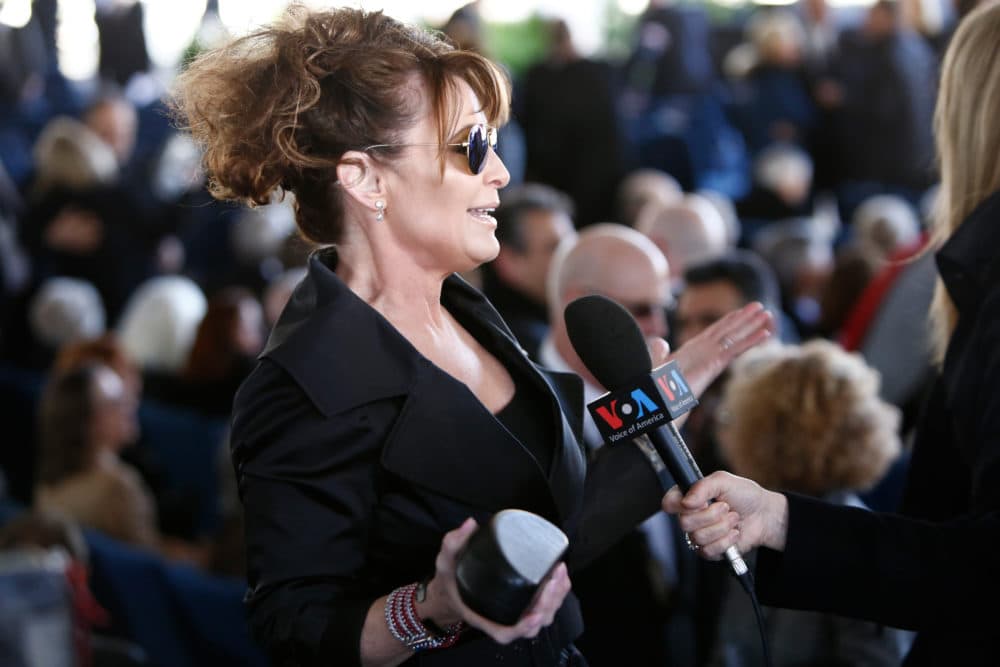Advertisement
Commentary
Sarah Palin’s libel lawsuit is bad news

As Sarah Palin’s libel suit against The New York Times begins in New York, I hope the thousands of UMass students who’ve studied "Journalism & Law" with me over the past 34 years remember what I've told them:
That the 1964 New York Times v. Sullivan precedent — on which Palin’s case will turn — was “an occasion for dancing in the streets.”
Those words from a First Amendment scholar are as true today as they were 58 years ago. Sullivan is the lifeblood of our democracy because it allows the media to hold the government accountable through critical reporting as long as that reporting is done without “actual malice,” defined as knowingly reporting false information or reporting with reckless disregard for the truth.
Palin is suing over a sentence in a 2017 Times editorial that suggested a link between the 2011 shooting of Rep. Gabby Giffords and Palin’s political action committee circulating a map of targeted electoral districts under stylized crosshairs.
Palin sued, and the Times immediately ran a correction saying there was no “link.”
Sullivan is the lifeblood of our democracy because it allows the media to hold the government accountable through critical reporting ...
The paper made a serious mistake but, the unanimous Sullivan precedent could save the Times today just as it did 58 years ago when L.B. Sullivan, the commissioner of police in Birmingham, Alabama, sued the paper for libel. Libel suits are meant to protect the plaintiff’s reputation, and Sullivan argued that 14 minor errors of fact in a full-page ad placed by civil rights proponents had sullied his reputation. This was one of many libel suits brought by southern segregationists against northern newspapers.
The real purpose of these suits was to stop the media’s coverage of the civil rights movement through libel litigation that could be financially crippling.
And the segregationists might have been successful if the Supreme Court had not established the actual malice test for such suits. After the Sullivan case, public officials had to prove that the papers either knew what they printed was false or were guilty of reckless disregard for the truth in order to win libel suits.
Advertisement
Sullivan has become the bedrock of First Amendment protection of a free press. Such protection was necessary, Justice William Brennan wrote, so debate on public issues could be “uninhibited, robust and wide-open.”
Yet Trump and others like him have continued to bring libel suits against the media based on criticism of themselves.
My impassioned discussion of Justice Brennan’s argument for such “breathing space” for the media prompted one student to come early to the next class and draw a large heart on the board with these words inside it: “Karen List + William Brennan” — an accurate depiction of my admiration for the former justice.
Not surprisingly, Donald Trump — who treated the media as “enemies of the people” when he was president — has said he wants Sullivan overturned so he and other public officials could sue the media over coverage critical of them and win. He sued the Times over a 2016 story about two women’s allegations that he had touched them inappropriately, even though the story was thoroughly reported and he himself had bragged about his nonconsensual touching of women.
The Times attorney wrote to Trump’s attorney, saying: “It would have been a disservice not only to our readers but to democracy itself to silence their voices. We welcome the opportunity to have a court set him straight.” The suit was dismissed.
Yet Trump and others like him have continued to bring libel suits against the media based on criticism of themselves.
Supreme Court Justice Clarence Thomas has said he, too, thinks Sullivan should be overturned. Thomas has disparaged journalists since their coverage of Anita Hill’s charges of sexual harassment against him during his 1991 confirmation hearings. He narrowly won a seat on the court, then vowed to get even with those who had criticized him. Overturning Sullivan would be one of the best ways for him to do that.
Since Thomas has been the lone dissenter on the court more often than any other justice, his suggestion was not considered much of a threat. But now Associate Justice Neil Gorsuch also has indicated an interest in overturning Sullivan. The court’s conservative faction holds a 6-3 majority, and speculation is that a number of long-held precedents could be set aside in coming years.
The first judge who reviewed Palin’s case dismissed it, but on appeal, a three-judge panel reinstated the suit, which now will go to a jury trial.
I hope my students remember that the jury in 1964 decided against the Times, as did the Alabama Supreme Court. It was the U.S. Supreme Court that protected journalism’s role as an agent for change in our democracy.
Some of my students have become attorneys themselves. Hundreds of others are working journalists. And any of them with a vested interest in journalism’s watchdog role in our democracy — which should be all of them — must be prepared to do some fast tap-dancing to stay on top of this issue in the years ahead.
